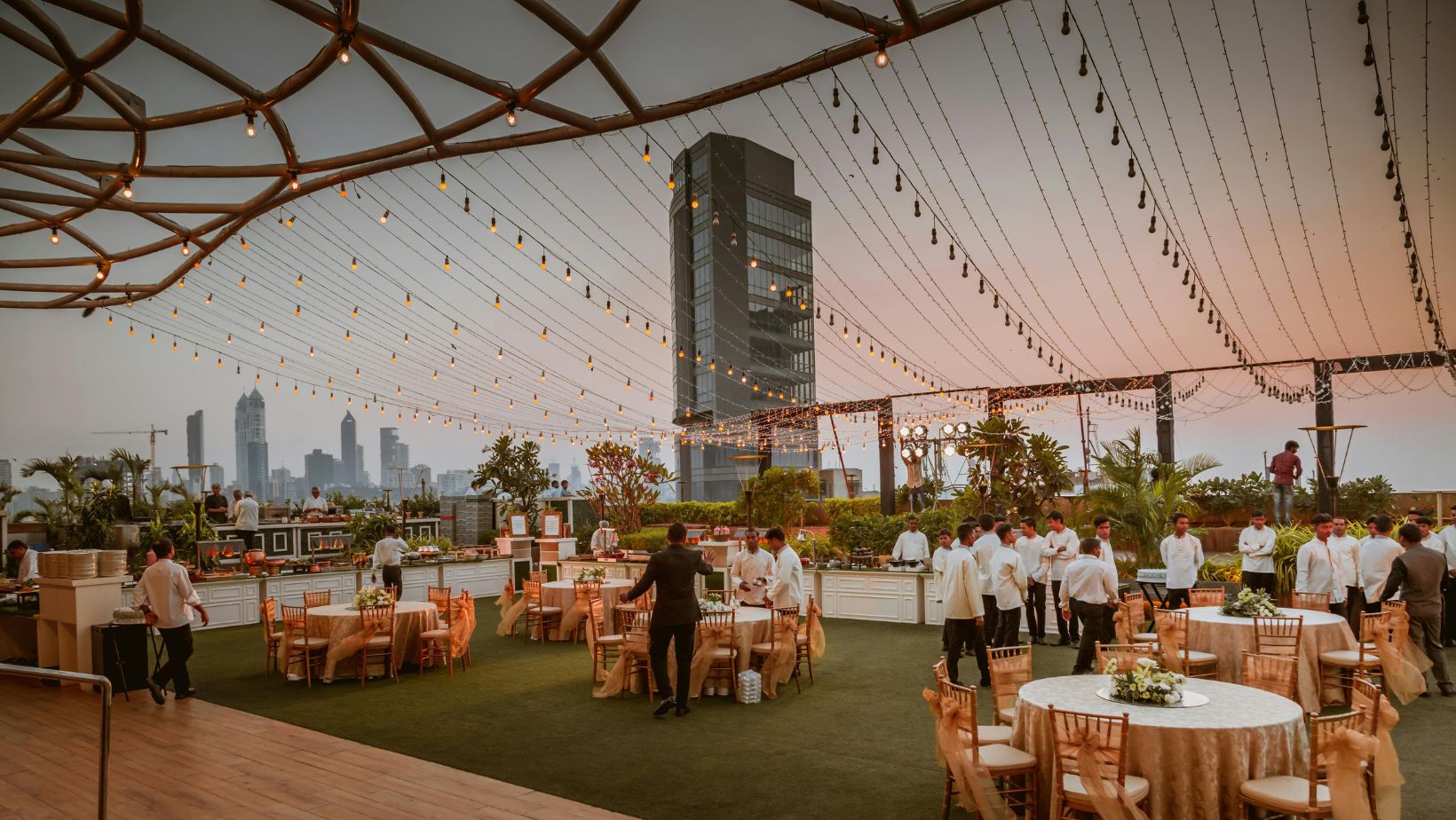Planning an outdoor event presents unique challenges that indoor venues don’t. The open-air setting offers beauty and freedom, but it also creates obstacles that you must prepare for.
You can create successful events by learning to avoid common pitfalls that derail even experienced planners.
1. Underestimating Weather Impacts
Weather affects every aspect of outdoor events, yet many planners fail to prepare for changing conditions. Planners often check the forecast only a few days before the event and lack backup options when the weather changes.
This short-sighted approach leads to soaked guests, damaged equipment, and sometimes completely canceled events. You should book venues with indoor backup spaces whenever possible to protect against weather emergencies.
Reserve tents or canopies well in advance since availability disappears quickly during peak seasons. Create a clear weather contingency plan and share it with all vendors so everyone knows their responsibilities when conditions change. Include specific weather provisions in your contracts to clarify cancellation policies and financial obligations. Consider weather insurance for large-scale events where significant money stands at risk.
Weather preparation costs money but pays off when rain, wind, or extreme temperatures threaten your event. The cost of solid contingency plans pales in comparison to the financial and reputational damage of last-minute cancellations.
2. Improper Sanitation Facility Planning
Restroom facilities rank low on the excitement scale but high on the necessity list. Poor planning here creates unhappy guests and potential health code violations that can shut down your event. Insufficient units, poor placement, and inadequate maintenance lead to long lines, unpleasant smells, and frustrated attendees who remember bathroom problems more than your carefully planned activities.
You should calculate your sanitation needs based on guest count and event duration. The general rule requires one porta potty unit per 20-25 guests to prevent excessive wait times. Place all units on flat, level ground to ensure stability and prevent tipping hazards during your event.
The Department of Health requires keeping sanitation facilities at least 100 feet away from any food preparation or serving areas to prevent contamination risks. Position units downwind from main event areas so odors don’t drift into dining or gathering spaces. Schedule regular servicing for multi-day events to maintain cleanliness standards throughout your program.
Accessibility matters tremendously with sanitation planning. The Americans with Disabilities Act requires one handicap-accessible toilet for every 20 standard units at events and public spaces. These accessible units need clear pathways and proper space for wheelchair maneuverability to truly serve all guests.
Proper porta potty placement combines practical considerations with regulatory requirements to create a better experience for everyone.
3. Insufficient Permit Research
Different municipalities have different requirements for outdoor events, which vary widely in complexity and cost. Overlooking permit requirements can shut down your event before it starts or result in substantial fines that destroy your budget. Planners often discover their permit needs too late, face unexpected fees that weren’t budgeted for, or receive citations for non-compliance, which can damage their professional reputations.
Start your permit research at least 3 to 6 months before your event date to allow enough processing time. Contact local government offices directly for specific requirements, as online information may not cover recent changes to local regulations.
Check for noise ordinances that restrict sound levels or mandate end times for music and amplified sound. Secure all necessary permits for alcohol service, food handling, and sanitation facilities, as these areas are subject to particular scrutiny from authorities. Verify whether you need special permits for tents exceeding specific sizes, stages that require inspection, or electrical setups that must meet safety codes.
Many localities require specific permits for placing portable toilets on public property, such as parks, streets, or sidewalks. You should contact your local municipality early to learn about the requirements and complete the application process before the installation dates. Permit requirements may also address placement constraints, such as minimum distances from water sources or property lines.
4. Overlooking Accessibility Requirements
Accessibility remains an afterthought for many event planners, creating unnecessary barriers for guests with disabilities and potential legal issues that could have been easily avoided. Uneven terrain makes navigation impossible for wheelchair users, while insufficient accessible facilities and poor signage create frustrating and exclusionary environments that deter guests from attending your event.
Perform a thorough site walkthrough focusing specifically on accessibility concerns before finalizing your venue selection. Create clear, accessible paths connecting all key areas by addressing surface issues and removing obstacles that block wheelchair movement.
Provide designated accessible parking spaces close to entrances so that guests with mobility challenges can participate without feeling exhausted. Ensure you supply the proper quantity of accessible restrooms based on your total facilities and expected attendance. Train all staff members on accessibility needs and appropriate assistance techniques so they can respond helpfully without overstepping boundaries.
The Americans with Disabilities Act requires one handicap-accessible toilet for every 20 standard units at events and public spaces to ensure equitable access. These specialized units need clear, level access paths and adequate surrounding space for wheelchair maneuverability. Accessibility planning demonstrates respect for all your guests while protecting you from potential complaints or legal actions.
5. Poor Vendor Coordination
Multiple vendors operating in the same space without clear guidance lead to chaos, delays, and mistakes that compound throughout your event day. Vendors frequently arrive at incorrect times, block each other’s access routes, or miss critical setup windows when coordination falls short. These timing issues create domino effects that damage your carefully planned schedule and frustrate both vendors and guests.
Create detailed site maps that show each vendor’s specific location, with measurements and boundaries clearly marked. Schedule staggered delivery and setup times so vendors can work efficiently without competing for access points or setup space. Designate specific parking areas for vendor vehicles to prevent blocked pathways or unauthorized parking that disrupts your event flow.
Establish a single central point of contact for all vendor questions to ensure consistent information and prevent conflicting instructions. Conduct a mandatory pre-event meeting with all key vendors to review expectations and address potential conflicts before they occur.
Your site maps must include the locations of sanitation facilities with clear access paths for servicing teams throughout the event. Portable toilets need to be strategically placed where service trucks can easily reach them for cleaning and maintenance. The industry standard requires positioning units within 25 feet of where maintenance vehicles can park to ensure proper servicing. Effective vendor coordination prevents the common problem of inaccessible sanitation units that can’t receive necessary maintenance during your event.
Conclusion
Successful outdoor events demand careful attention to these five critical areas that inexperienced planners often overlook. Weather preparation protects your investment against unpredictable elements. Thorough sanitation planning ensures guest comfort and health code compliance. Complete permit research prevents legal complications that could shut down your event. Accessibility considerations demonstrate respect for all attendees. Detailed vendor coordination creates smooth operations throughout your event timeline.
By addressing these common mistake areas early in your planning process, you create the foundation for events that delight guests and run without major disruptions. The time you invest in thorough planning pays tremendous dividends through stress reduction during your event and increased guest satisfaction with the experience you create.
Start your planning processes early with realistic timelines for each phase. Create detailed contingency plans for aspects beyond your control. Remember that the least glamorous elements of event planning—like proper sanitation facility placement—often make the biggest difference in how guests experience and remember your event.




More Stories
Comprehensive Guide to Roofing Maintenance and Longevity Tips
Garage Door Operators: The Facts According to the Experts
From Courtside Precision to Backyard Intelligence: How NBA Tech Inspires Smarter Living